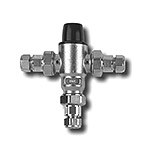
How Thermostatic Mixing Valves (TMVs) Help Prevent Legionella and Scalding
A thermostatic mixing valve (TMV) is a safety device designed to blend hot and cold water to deliver water at a safe, pre-set temperature – typically between 38°C and 46°C. TMVs are widely used in commercial and healthcare environments to prevent scalding, particularly for vulnerable individuals such as children, the elderly, and those with reduced mobility.
Balancing Legionella Control and Scalding Prevention
One of the most effective ways to prevent Legionella bacteria in water systems is through temperature control. According to health and safety guidelines, hot water must be stored above 60°C to eliminate Legionella, and it should reach at least 50°C at outlets to remain effective in reducing bacterial risk.
However, water at these temperatures presents a serious scalding hazard, especially for vulnerable individuals. This creates a safety challenge where two risks — scalding and Legionella — must be managed together.
This is precisely where thermostatic mixing valves (TMVs) come in. TMVs allow water to be stored at high temperatures (to control Legionella) while ensuring safe delivery temperatures at the tap or shower, preventing scalding. Regular TMV maintenance is essential to ensure this balance is maintained over time.
Book TMV service now

TMV Installation Best Practices to Minimise Legionella Risk
While thermostatic mixing valves (TMVs) are essential for preventing scalding, they can increase the risk of Legionella if not correctly installed and maintained.
Water in pipework downstream of a TMV can fall below 50°C, creating ideal conditions for Legionella bacteria to grow. To mitigate this risk, TMVs should be installed within 2 metres of the outlet, ensuring minimal volumes of lukewarm water sit stagnant in the system.
During a Legionella risk assessment, it’s also important to evaluate whether a TMV is actually needed. If the scalding risk is deemed insignificant, the TMV may be safely removed to reduce unnecessary bacterial risk.
5 Key TMV Installation Guidelines for Legionella Control
- Integrate the TMV into the tap fitting, so hot and cold water are mixed directly at the outlet.
- Avoid TMVs on low-flow spray taps, which can increase Legionella risk due to low velocity and potential aerosol generation.
- Install the TMV as close as possible (within 2m) to the outlet to reduce the volume of lukewarm stored water.
- Use one TMV per outlet – avoid feeding multiple fixtures (e.g. a bank of basins or showers) from a single valve.
Be aware of underused outlets – a cold tap connected to a TMV can become a “little-used outlet” requiring regular flushing (at least weekly).
TMVs should be serviced at least once a year, or as specified in your Legionella risk assessment. Regular servicing ensures the valve functions correctly to prevent scalding and maintain temperature control.
In healthcare settings such as hospitals, TMVs must be checked every six months in accordance with HTM 04-01 guidelines.
TMV servicing is usually carried out in batches for efficiency. For example, servicing 40 TMVs at a large secondary school typically costs £25–£29 per valve. This includes removal, cleaning, disinfection, and function testing.
All serviced valves are tagged with a unique service ID and logged via our electronic compliance system, giving you real-time access to reports, pass/fail status, and full maintenance history.
A standard TMV service involves:
-
Isolating and removing the valve
-
Cleaning and disinfecting internal parts
-
Reassembling and testing for correct temperature regulation
-
Logging performance data for compliance reporting
This ensures the valve continues to deliver safe water temperatures and reduces Legionella risk.
Not always. Whether a TMV is required depends on the outcome of a Legionella risk assessment and the scalding risk to users. In low-risk environments, TMVs may not be necessary, and removing them can even reduce bacterial risk.
Without regular TMV maintenance, the valve may:
-
Fail to control water temperature
-
Increase the risk of scalding
-
Allow conditions for Legionella bacteria to grow
-
Breach HSE and HTM compliance in regulated environments
Routine servicing is essential for user safety and legal compliance.
